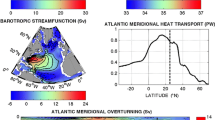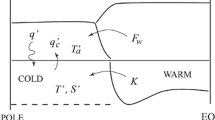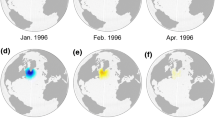Abstract
We examine the dynamics of thresholds of the Atlantic Meridional Overturning Circulation (AMOC) in an Atmosphere–Ocean General Circulation Model (AOGCM) and a simple box model. We show that AMOC thresholds in the AOGCM are controlled by low-order dynamics encapsulated in the box model. In both models, AMOC collapse is primarily initiated by the development of a strong salinity advection feedback in the North Atlantic. The box model parameters are potentially observable properties of the unperturbed (present day) ocean state, and when calibrated to a range of AOGCM states predict (within some error bars) the critical rate of fresh water input (Hcrit) needed to turn off the AMOC in the AOGCM. In contrast, the meridional fresh water transport by the MOC (MOV, a widely-used diagnostic of AMOC bi-stability) on its own is a poor predictor of Hcrit. When the AOGCM is run with increased atmospheric carbon dioxide, Hcrit increases. We use the dynamical understanding from the box model to show that this increase is due partly to intensification of the global hydrological cycle and heat penetration into the near-surface ocean, both robust features of climate change projections. However changes in the gyre fresh water transport efficiency (a less robustly modelled process) are also important.










Similar content being viewed by others
Notes
The main FAMOUSA experiment, discussed here and in H11, is denoted SCOMP in J17. We briefly discuss a second FAMOUSA experiment, denoted VCOMP in J17, in Sect. 5.3 below.
References
Alkhayuon H, Ashwin P, Jackson LC, Quinn C, Wood RA (2019) Basin bifurcations, oscillatory instability and rate-induced thresholds for Atlantic meridional overturning circulation in a global oceanic box model. Proc R Soc A 475:20190051. https://doi.org/10.1098/rspa.2019.0051
Alley RB (2003) Palaeoclimatic insights into future climate challenges. Philos Trans R Soc A 361:1831–1848
Bakker P, Schmittner A, Lenaerts JTM, Abe-Ouchi A, Bi D, van den Broeke MR, Chan WL, Hu A, Beadling RL, Marsland SJ, Mernild SH, Saenko OA, Swingedouw D, Sullivan A, Yin J (2016) Fate of Atlantic meridional overturning circulation: strong decline under continued warming and Greenland melting. Geophys Res Lett 43:12252–12260. https://doi.org/10.1002/2016gl070457
Bryden HL, Imawaki S (2001) Ocean heat transport. In: Siedler G, Church J, Gould J (eds) Ocean circulation and climate. Academic Press, New York, pp 455–474
Cheng W, Weijer W, Kim WM, Danabasoglu G, Yeager SG, Gent PR, Zhang D, Chang JCH, Zhang J (2018) Cn the salt advection feedback be detected in internal variability of the Atlantic meridional overturning circulation? J Clim 31:6649–6667. https://doi.org/10.1175/jcli-d-17-0825.1
Cimatoribus AA, Drijfhout SS, den Toom M, Dijkstra HA (2012) Sensitivity of the Atlantic meridional overturning circulation to South Atlantic freshwater anomalies. Clim Dyn 39:2291–2306. https://doi.org/10.1007/s00382-012-1292-5
Collins M, Knutti R, Arblaster J, Dufresne J-L, Fichefet T, Friedlingstein P, Gao X, Gutowski WJ, Johns T, Krinner G, Shongwe M, Tebaldi C, Weaver AJ, Wehner M (2013) Long-term climate change: projections, commitments and irreversibility. In: Stocker TF, Qin D, Plattner G-K, Tignor M, Allen SK, Boschung J, Nauels A, Xia Y, Bex V, Midgley PM (eds) Climate Change 2013: the physical science basis. Contribution of Working Group I to the Fifth Assessment Report of the Intergovernmental Panel on Climate Change. Cambridge University Press, Cambridge and New York
Cox PM, Huntingford C, Williamson MS (2018) Emergent constraint on equilibrium climate sensitivity from global temperature variability. Nature 553:319–322
Den Toom M, Dijkstra HA, Weijer W, Hecht MW, Maltrud ME, Van Sebile E (2014) Response of a strongly eddying global ocean to north atlantic freshwater perturbations. J Phys Ocenaogr 44:464–481. https://doi.org/10.1175/JPO-D-12-0155.1
deVries P, Weber SL (2005) The Atlantic fresh water budget as a diagnostic for the existence of a stable shut down of the meridional overturning circulation. Geophys Res Lett. https://doi.org/10.1029/2004GL021450
Dijkstra HA (2007) Characterization of the multiple equilibria regime in a global ocean model. Tellus A 59:695–705. https://doi.org/10.1111/j.1600-0870.2007.00267.x
Dijkstra HA, Neelin JD (1999) Imperfections of the thermohaline circulation: multiple equilibria and flux correction. J Clim 12:1382–1392
Dijkstra HA, Te Raa L, Weijer W (2004) A systematic approach to determine thresholds of the ocean’s thermohaline circulation. Tellus A 56:362–370. https://doi.org/10.1111/j.1600-0870.00058.x
Döös K (1995) Interocean exchange of water masses. J Geophys Res 100:13499–13514
Drijfhout SS, Weber SL, van der Swaluw E (2011) The stability of the MOC as diagnosed from model projections for pre-industrial, present and future climates. Clim Dyn 37:1575–1586
Fichefet T, Poncin C, Goosse H, Huybrechts P, Janssens I, Le Treut H (2003) Implications of changes in freshwater flux from the Greenland ice sheet for the climate of the 21st century. Geophys Res Lett. https://doi.org/10.1029/2003GL017826
Gnanadesikan A (1999) A simple predictive model for the structure of the oceanic pycnocline. Science 283:2077–2079
Gordon C, Cooper C, Senior CA, Banks HT, Gregory JM, Johns TC, Mitchell JFB, Wood RA (2000) The simulation of SST, sea ice extents and ocean heat transports in a version of the Hadley Centre coupled model without flux adjustments. Clim Dyn 16:147–168
Gregory JM (2000) Vertical heat transports in the ocean and their effect on time-dependent climate change. Clim Dyn 16:501–515
Gregory JM et al (2005) A model intercomparison of changes in the thermohaline circulation in response to increasing atmospheric CO2 concentration. Geophys Res Lett. https://doi.org/10.1029/2005GL023209
Hall A, Qu X (2006) Using the current seasonal cycle to constrain snow albedo feedback in future climate change. Geophys Res Lett 33:L03502
Hawkins E, Smith RS, Allison LC, Gregory JM, Woollings TJ, Pohlmann H, de Cuevas B (2011) Bistability of the Atlantic overturning circulation in a global climate model and links to ocean freshwater transport. Geophys Res Lett 38:L10605. https://doi.org/10.1029/2011GL047208
Hofmann M, Rahmstorf S (2009) On the stability of the Atlantic meridional overturning circulation. Proc Natl Acad Sci. https://doi.org/10.1073/pnas.0909146106
Hu AGA, Meehl W, Han A, Abe-Ouchi C, Morrill Y Ozaki, Chikamoto MO (2012) The Pacific-Atlantic seesaw and the Bering Strait. Geophys Res Lett 39:L03702. https://doi.org/10.1029/2011GL050567
Hughes TMC, Weaver AJ (1994) Multiple equilibria of an asymmetric 2-basin ocean model. J Phys Oceanogr 24:619–637
Huisman SE, Den Toom M, Dijkstra HA, Drijfhout S (2010) An indicator of the multiple equilibria regime of the Atlantic meridional overturning circulation. J Phys Oceanogr 40:551–567. https://doi.org/10.1175/2009JPO4215.1
Jackson LC (2013) Shutdown and recovery of the AMOC in a coupled global climate model: the role of the advective feedback. Geophys Res Lett 40:1182–1188. https://doi.org/10.1002/grl.50289
Jackson LC, Wood RA (2018) Hysteresis and resilience of the AMOC in an eddy-permitting GCM. Geophys Res Lett. https://doi.org/10.1029/2018gl078104
Jackson L, Kahana R, Graham T, Ringer MA, Woolings T, Mecking JV, Wood RA (2015) Global and European climate impacts of a slowdown of the AMOC in a high resolution GCM. Clim Dyn 45:3299–3316. https://doi.org/10.1007/s00382-015-2540-2
Jackson LC, Smith RS, Wood RA (2017) Ocean and atmosphere feedbacks affecting AMOC hysteresis in a GCM. Clim Dyn. https://doi.org/10.1007/s00382-016-3336-9
Johnson HL, Marshall DP, Sproson DAJ (2007) Reconciling theories of a mechanically driven meridional overturning circulation with thermohaline forcing and multiple equilibria. Clim Dyn 29:821–836. https://doi.org/10.1007/s00382-007-026249
Jungclaus JH, Fischer N, Haak H, Lohmann K, Marotzke J, Matei D, Mikolajewicz U, Notz D, von Storch JS (2013) Characteristics of the ocean simulations in the Max Planck Institute Ocean Model (MPIOM) the ocean component of the MPI-Earth system model. J Adv Modell Earth Syst 5:422–446
Kageyama M, Merkel U, Otto-Bliesner B, Prange M, Abe-Ouchi A, Lohmann G, Ohgaito R, Roche DM, Singarayer J, Swingedouw D, Zhang X (2013) Climatic impacts of fresh water hosing under Last Glacial Maximum conditions: a multi-model study. Clim Past 9:935–953. https://doi.org/10.5194/cp-9-935-2013
Landerer FW, Jungclaus JH, Marotzke J (2007) Regional dynamic and steric sea level change in response to the IPCC-A1B scenario. J Phys Oceanogr 37:296–312
Lenton TM et al (2007) Effects of atmospheric dynamics and ocean resolution on bi-stability of the thermohaline circulation examined using the Grid ENabled Integrated Earth system modelling (GENIE) framework. Clim Dyn 29:591–613
Liu W, Xie S, Liu Z, Zhu J (2017) Overlooked possibility of a collapsed Atlantic meridional overturning circulation in warming climate. Sci Adv 3:e1601666
Lucarini V, Stone PH (2005) Thermohaline circulation stability: a box model study. Part I: uncoupled model. J Phys Oceanogr 18:501–513
Manabe S, Stouffer RJ (1988) Two stable equilibria of a coupled ocean-atmosphere model. J Clim 1:841–863
Marotzke J, Stone PH (1995) Atmospheric transports, the thermohaline circulation, and flux adjustments in a simple coupled model. J Phys Oceanogr 25:1350–1364
Martin GM et al (2011) The HadGEM2 family of Met Office Unified Model climate configurations. Geosci Model Dev 4:723–757
Mecking JV, Drijfhout SS, Jackson LC, Andrews MB (2017) Theeffect of model bias on Atlantic freshwater transport and implications for AMOC bi-stability. Tellus A 69:1. https://doi.org/10.1080/16000870.2017.1299910
Mikolajewicz U et al (2007) Long-term effects of anthropogenic CO2 emissions simulated with a complex earth system model. Clim Dyn 6:599–631
Muglia J, Skinner LC, Schmittner A (2018) Weak overturning circulation and high Southern Ocean nutrient utilization maximised glacial ocean carbon. Earth Plan Sci Lett 496:47–56. https://doi.org/10.1016/j.epsl.2018.05.038
Rahmstorf S (1996) On the freshwater forcing and transport of the Atlantic thermohaline circulation. Clim Dyn 12:799–811. https://doi.org/10.1007/s003820050144
Rahmstorf S et al (2005) Thermohaline circulation hysteresis: a model intercomparison. Geophys Res Lett 32:L23605. https://doi.org/10.1029/2005GL023655
Rodríguez JA, Johns TC, Thorpe RB, Wiltshire A (2011) Using moisture conservation to evaluate oceanic surface freshwater fluxes in climate models. Clim Dyn 37:205–219
Schneider SH, Semenov S, Patwardhan A, Burton I, Magadza CHD, Oppenheimer M, Pittock ABV, Rahman A, Smith JB, Suarez A, Yamin F (2007) Assessing key vulnerabilities and the risk from climate change. In: Parry ML, Canziani OF, Palutikof JP, van der Linden PJ, Hansen CE (eds) Climate change 2007: impacts, adaptation and vulnerability. Contribution of Working Group II to the Fourth Assessment Report of the Intergovernmental Panel on Climate Change. Cambridge University Press, Cambridge, pp 779–810
Sijp WP (2012) Characterising meridional overturning bistability using a minimal set of state variables. Clim Dyn 39:2127–2142
Smith RS (2012) The FAMOUS climate model (versions XFXWB and XFHCC): description and update to version XDBUA. Geosci Model Dev 5:269–276
Smith RS, Gregory JM (2009) A study of the sensitivity of ocean overturning circulation and climate to freshwater input in different regions of the North Atlantic. Geophys Res Lett. https://doi.org/10.1029/2009GL038607
Smith DM et al (2007) Improved surface temperature prediction for the coming decade from a global climate model. Science 317:796–799
Smith RS, Gregory JM, Osprey A (2008) A description of the FAMOUS (version XDBUA) climate model and control run. Geosci Model Dev 1:53–68
Speich S, Blanke B, Madec G (2001) Warm and cold water routes of an O.G.C.M. thermohaline conveyor belt. Geophys Res Lett 28:311–314
Stocker TF, Schmittner A (1997) Influence of CO2 emission rates on the stability of the thermohaline circulation. Nature 388:862–864
Stommel H (1961) Thermohaline convection with two stable regimes of flow. Tellus 13:224–230
Stouffer RJ, Dixon KW, Spelman MJ, Hurlin W, Yin J, Gregory JM, Weaver AJ, Eby M, Flato GM, Robitaille DY, Hasumi H, Oka A, Hu A, Jungclaus JH, Kamenkovich IV, Levermann A, Nawrath S, Montoya M, Murakami S, Peltier WR, Vettoretti G, Sokolov A, Weber SL (2006) Investigating the causes of the response of the thermohaline circulation to past and future climate changes. J Clim 19(8):1365–1387
Swingedouw D, Rodehacke CB, Olsen SM, Menary M, Gao Y, Mikolajewicz U, Mignot J (2015) On the reduced sensitivity of the Atlantic overturning to Greenland ice sheet melting in projections: a multi-model assessment. Clim Dyn 44:3261–3279. https://doi.org/10.1007/s00382-014-2270-x
Talley LD, Pickard GL, Emery WJ, Swift JH (2011) Descriptive physical oceanography: an introduction, 6th edn. Academic Press, Oxford, p 555
Thorpe R, Gregory JM, Johns TC, Wood RA, Mitchell JFB (2001) Mechanisms determining the Atlantic thermohaline circulation response to greenhouse gas forcing in a non-flux-adjusted coupled climate model. J Clim 14:3102–3116
Valdes P (2011) Built for stability. Nat Geosci 4:414–416
Vellinga M, Wood RA (2002) Global climate impacts of a collapse of the Atlantic thermohaline circulation. Clim Change 54:251–267
Weber SL, Drijfhout SS, Abe-Ouchi A, Crucifix M, Eby M, Ganopolski A, Murakami S, Otto-Bliesner B, Peltier WR (2007) The modern and glacial overturning circulation in the Atlantic Ocean in PMIP coupled model simulations. Clim Past 3:51–64
Acknowledgements
RAW, JMR and LCJ were supported by the Joint UK BEIS/Defra Met Office Hadley Centre Climate Programme (GA01101).
Author information
Authors and Affiliations
Corresponding author
Additional information
Publisher's Note
Springer Nature remains neutral with regard to jurisdictional claims in published maps and institutional affiliations.
Rights and permissions
About this article
Cite this article
Wood, R.A., Rodríguez, J.M., Smith, R.S. et al. Observable, low-order dynamical controls on thresholds of the Atlantic meridional overturning circulation. Clim Dyn 53, 6815–6834 (2019). https://doi.org/10.1007/s00382-019-04956-1
Received:
Accepted:
Published:
Issue Date:
DOI: https://doi.org/10.1007/s00382-019-04956-1




